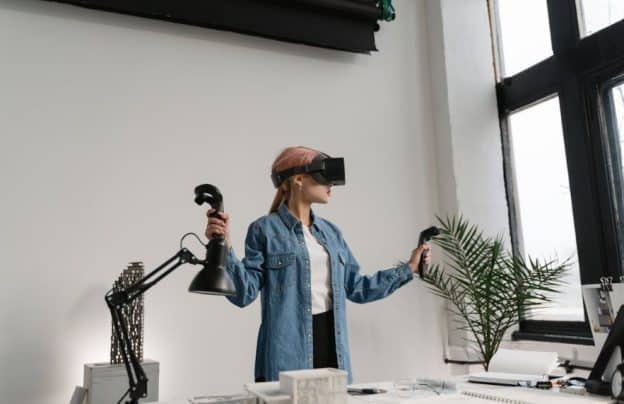The modern workplace is undergoing a remarkable transformation. What was once a static environment filled with cubicles and filing cabinets has evolved into a connected ecosystem of devices, data, and intelligent systems.
Artificial intelligence and smart technology are reshaping how offices function, creating environments that are not only more efficient but also healthier and more comfortable for employees. These innovations are redefining how we think about productivity, sustainability, and the role of technology in everyday work life.
Smart Environmental Controls for a Healthier Workplace
Creating the perfect office environment involves more than adjusting the thermostat. Smart technology now allows buildings to monitor and adapt to changes in air quality, temperature, and humidity automatically. Many offices use sensors that detect occupancy, allowing systems to adjust lighting and climate control only when spaces are in use. This reduces waste while keeping conditions pleasant for workers.
Simple tools also play an important part in maintaining a balanced environment. For instance, desiccant packs are often placed in storage rooms or equipment areas to help absorb moisture and prevent damage to electronics or important documents.
When paired with smart systems that track humidity and air quality, small additions like these contribute to a more stable and comfortable workspace that promotes both employee well-being and long-term efficiency.
AI-Powered Energy Efficiency: Reducing Costs and Carbon Footprints
Artificial intelligence has become a key player in helping offices operate more sustainably. Smart building systems use AI to analyze energy usage patterns, adjusting lighting, heating, and cooling automatically throughout the day. Instead of running on fixed schedules, these systems learn from human behavior and weather conditions, fine-tuning operations to minimize waste.
This level of control not only reduces energy costs but also supports corporate sustainability goals. Many companies are now integrating renewable energy sources with smart management systems, allowing AI to determine when solar or wind energy should be prioritized.
Some offices even use predictive models to anticipate energy demand based on employee attendance patterns. The result is a workplace that conserves resources while keeping employees comfortable and productive, proving that intelligent design can benefit both the environment and the bottom line.
Smart Office Security: From Facial Recognition to Predictive Analytics
Security has taken on new meaning in the age of smart technology. Traditional keycards and passwords are being replaced by biometric systems such as facial recognition or fingerprint scanning, offering a higher level of protection for both employees and data. AI also enhances security by analyzing access patterns, identifying unusual behavior, and alerting management to potential risks before they escalate.
Modern offices also rely on intelligent surveillance systems that use machine learning to detect movement or objects that seem out of place. These systems provide real-time insights without constant human monitoring, reducing the chance of oversight and improving response times. The result is a more secure environment that still feels open and welcoming to those who work there.
Employee Experience: Personalized Workspaces and Wellness Tech
AI is not just about efficiency and security. It is also enhancing how employees experience their work environment. Smart systems can personalize lighting, desk height, and even background music based on an individual’s preferences or schedule. For example, an employee who prefers cooler lighting in the morning and warmer tones in the afternoon can have their workspace adjusted automatically.
Wellness technology is also becoming an essential part of modern offices. Sensors can track air quality, noise levels, and even employee posture, offering gentle reminders to take breaks or stretch.
Some offices are experimenting with AI-driven wellness apps that suggest the best times for meetings or breaks based on concentration patterns. By combining technology with empathy, businesses can foster an environment that supports mental focus, physical health, and overall happiness at work.
The Future of Office Management: Data-Driven Decision Making
AI and smart technology provide managers with detailed insights into how offices are used. Occupancy sensors can reveal which meeting rooms are frequently empty and which areas are overused. This information helps decision-makers optimize layouts, reduce wasted space, and plan future expansions more intelligently.
Predictive maintenance is another area where AI adds significant value. Systems can alert facilities teams to potential equipment failures before they happen, reducing downtime and repair costs. For example, HVAC systems connected to AI networks can predict when filters or components need attention, ensuring the office remains comfortable and efficient year-round.
By combining these predictive tools with real-time data, businesses can make informed choices about space utilization, staffing, and operational efficiency. The office of the future is not just smart—it is adaptive, learning from every interaction to continually improve itself.
Conclusion
Artificial intelligence and smart technology are redefining what it means to have a modern office. From the use of desiccant packs in climate-controlled environments to advanced AI systems that manage energy and security, every innovation contributes to a more sustainable, efficient, and people-focused workplace. As these technologies continue to evolve, the office will no longer be just a place to work—it will be an intelligent partner that helps businesses and employees thrive together.


